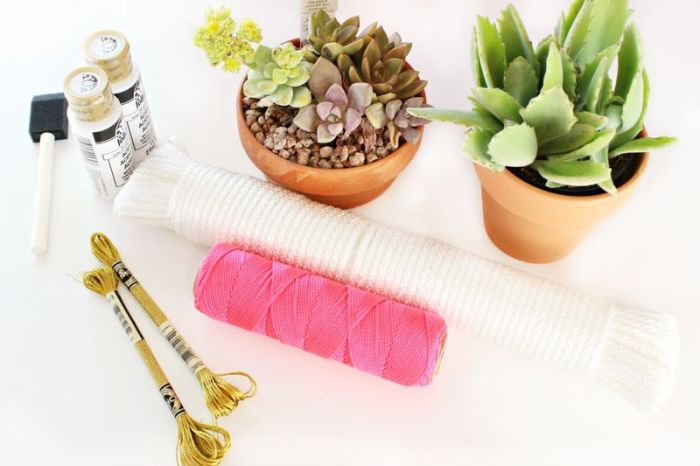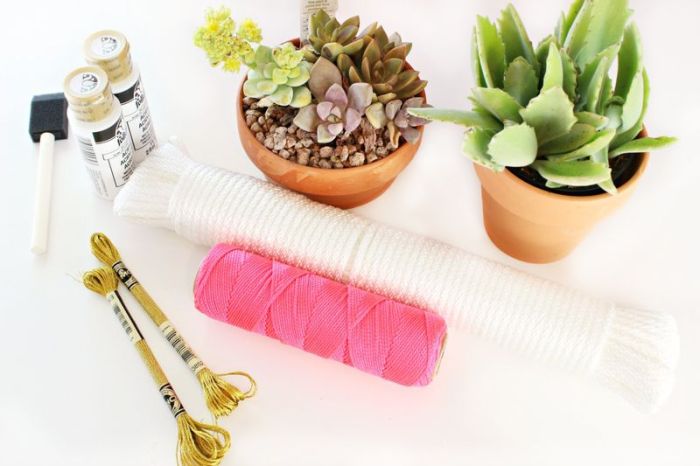
DIY rope wrapped planters are a fantastic way to add a touch of rustic charm and personality to your home decor. Whether you’re a seasoned crafter or a beginner, this project is surprisingly simple and offers endless possibilities for customization.
You can choose from a variety of ropes, colors, and embellishments to create planters that perfectly reflect your style.
From natural sisal to colorful cotton rope, the materials used in this project are readily available and often quite affordable. With a little creativity, you can transform ordinary planters into unique and eye-catching pieces that enhance your indoor or outdoor spaces.
DIY Rope Wrapped Planters

Adding a touch of rustic charm to your home decor is easier than you think. DIY rope wrapped planters are a fantastic way to elevate your plant game and create a cozy, welcoming atmosphere. This project is perfect for beginners, requiring minimal tools and offering endless creative possibilities.
Materials Used in DIY Rope Wrapped Planters
Rope-wrapped planters are a versatile craft that can be customized to suit your style and space. You can choose from a variety of materials, each with its own unique look and feel.
- Natural Rope:This is the most common material used for rope-wrapped planters, offering a natural and earthy aesthetic. It’s readily available in various thicknesses and colors, allowing you to create planters that blend seamlessly with your decor.
- Jute Rope:Jute rope is a durable and sustainable option, adding a rustic and earthy touch to your planters. It’s known for its natural texture and rich brown color, creating a warm and inviting ambiance.
- Cotton Rope:Cotton rope offers a softer and more delicate look, perfect for creating planters with a vintage or bohemian feel. It’s available in various colors, allowing you to personalize your planters to match your style.
- Synthetic Rope:For a more modern and sleek look, synthetic rope is a great choice. It’s available in a wide range of colors and patterns, allowing you to create planters that stand out and complement your contemporary decor.
Techniques for Wrapping the Rope
Now that you have your materials, it’s time to start wrapping! There are a variety of techniques you can use to create different looks. Let’s explore some of the most popular methods.
Wrapping Techniques
The basic method for wrapping rope around a planter involves securing the rope to the bottom of the planter and then wrapping it around the circumference in a spiral pattern. You can use a variety of techniques to achieve different effects, such as a simple spiral, a criss-cross pattern, or a diagonal pattern.
- Simple Spiral:This is the most basic and straightforward technique. Start by securing the rope at the bottom of the planter. Wrap the rope around the planter in a continuous spiral, overlapping each layer slightly. Continue wrapping until you reach the top of the planter.
Secure the end of the rope with a knot or glue. This method creates a clean and simple look.
- Criss-Cross Pattern:For a more intricate look, you can try a criss-cross pattern. Start by securing the rope at the bottom of the planter. Wrap the rope around the planter in a spiral, but instead of overlapping each layer, cross the rope over itself.
Continue wrapping until you reach the top of the planter. Secure the end of the rope with a knot or glue.
- Diagonal Pattern:To create a unique diagonal pattern, start by securing the rope at the bottom of the planter. Wrap the rope around the planter in a spiral, but instead of wrapping horizontally, wrap the rope diagonally. Continue wrapping until you reach the top of the planter.
Secure the end of the rope with a knot or glue.
Creating Texture and Patterns
You can create different textures and patterns with the rope by using different types of rope, adding embellishments, or using a combination of techniques.
- Using Different Rope Types:Using a variety of rope types can create different textures. For example, using a thicker rope will create a more rustic look, while using a thinner rope will create a more delicate look. You can also use different colors of rope to create a more dynamic look.
- Adding Embellishments:You can add embellishments to your rope-wrapped planters to create a more personalized look. For example, you can add beads, buttons, or even small plants to the rope. You can also use different colors of paint to create a more colorful look.
DIY rope wrapped planters are a great way to add a touch of rustic charm to your home decor. I love how they can transform simple pots into something unique and eye-catching. Speaking of unique and eye-catching, have you seen the new spring summer maple jewelry collection ?
It’s absolutely stunning! Anyway, back to the planters, I’m planning to make a few more for my balcony this weekend. They’re so versatile and can be customized to match any style.
- Combining Techniques:You can combine different wrapping techniques to create unique and interesting patterns. For example, you can start with a simple spiral and then add a criss-cross pattern to the top of the planter. You can also use different colors of rope to create a more dynamic look.
Achieving a Neat and Secure Finish, Diy rope wrapped planters
To achieve a neat and secure finish, it is important to use a strong glue to secure the rope to the planter. You can also use a hot glue gun to create a more permanent bond. Make sure to overlap the rope slightly as you wrap it around the planter to create a smooth and seamless finish.
I’ve been on a roll lately with DIY projects, especially after making those cute rope-wrapped planters for my balcony. It’s amazing how a little bit of twine can transform a plain pot into something so stylish. I even took a quick break from my crafting to head out on a quick biz trip to Phoenix , but I couldn’t resist picking up some more rope and terracotta pots for even more planter projects! Can’t wait to share the finished products.
If you are using a natural rope, you can use a sealant to protect it from the elements.
DIY rope wrapped planters are a great way to add a touch of rustic charm to your home. They’re surprisingly easy to make, and you can customize them to match your decor. If you’re feeling adventurous, you can even try your hand at sewing your own fabric planters using patterns you can find on sites like sewing patterns and getting started.
Once you’ve mastered the basics, you can use your sewing skills to create unique and personalized rope wrapped planters that will truly make your home feel like your own.
Finishing Touches and Variations
Once you’ve wrapped your planter with rope, it’s time to add your personal touch and transform it into a unique piece of home decor. There are endless possibilities for customization, from simple accents to elaborate embellishments.
Adding Decorative Elements
Adding decorative elements can elevate your rope-wrapped planter from basic to beautiful. These elements can range from simple accents like beads and ribbons to more elaborate designs like painted patterns and stencils.
- Beads:Adding beads to the rope can create a visual interest and add texture. You can use different colors and sizes of beads to create a unique look. You can also use beads to create patterns or designs on the planter.
- Ribbons:Ribbons can be tied around the planter or used to create bows. They can add a pop of color or a touch of elegance to your planter.
- Twine:Twine can be used to create patterns or designs on the planter. You can also use twine to attach other decorative elements, such as beads or ribbons.
Using Paints and Stains
Painting or staining your rope-wrapped planter can add a unique look and complement your home decor.
- Paints:You can use acrylic paints, spray paints, or even chalk paint to add color to your planter. You can use solid colors, patterns, or stencils to create a unique design.
- Stains:Stains can be used to add a natural wood finish to your planter. You can choose from a variety of colors and finishes to match your home decor.
Embellishments
Embellishments can add a touch of personality to your planter.
- Buttons:Buttons can be used to create patterns or designs on the planter. You can use different colors, sizes, and textures of buttons to create a unique look.
- Fabric scraps:Fabric scraps can be glued or sewn onto the planter to create a unique texture or design. You can use different colors and patterns of fabric to create a personalized look.
- Natural elements:Natural elements such as shells, stones, or twigs can be glued or tied onto the planter to add a natural touch. You can use different colors and textures of natural elements to create a unique look.
Incorporating the Planter into Home Decor
Your rope-wrapped planter can be a beautiful addition to your home decor, adding a touch of rustic charm or a modern accent.
- On a shelf or mantel:A rope-wrapped planter can be a beautiful focal point on a shelf or mantel. You can use different sizes and colors of planters to create a cohesive look.
- On a coffee table:A small rope-wrapped planter can be a great addition to a coffee table. You can use it to display a small plant or succulent.
- In a windowsill:A rope-wrapped planter can be a beautiful way to bring life to a windowsill. You can use it to display a flowering plant or a trailing vine.
- On a patio or balcony:A rope-wrapped planter can be a great way to add a touch of greenery to a patio or balcony. You can use it to display a variety of plants, from flowers to herbs.
Care and Maintenance
Rope wrapped planters, while visually appealing and unique, require some care and maintenance to ensure their longevity and beauty. Understanding how to properly care for your rope wrapped planter will help it stay in top condition for years to come.
Cleaning and Protecting the Rope
Regular cleaning is crucial for maintaining the appearance and extending the life of your rope wrapped planter.
- Dusting:Regularly dust the rope with a soft cloth or brush to remove accumulated dirt and debris. This prevents the buildup of grime that can dull the rope’s appearance and potentially attract pests.
- Spot Cleaning:For stains or spills, use a damp cloth with mild soap and water. Gently rub the affected area, avoiding excessive scrubbing that could damage the rope. Allow the area to air dry completely.
- Water Resistance:While some ropes are naturally water-resistant, it’s a good practice to protect your planter from prolonged exposure to water. A waterproof sealant can be applied to the rope to enhance its resistance to moisture and stains.
Lifespan and Longevity
The lifespan of a rope wrapped planter depends on the quality of the rope, the frequency of cleaning, and the environment in which it’s placed.
- Rope Quality:Natural fiber ropes, like sisal or jute, are generally more susceptible to wear and tear than synthetic ropes. Synthetic ropes, such as nylon or polypropylene, are often more durable and water-resistant.
- Environmental Factors:Exposure to direct sunlight, humidity, and extreme temperatures can accelerate the aging process of the rope. Placing your planter in a sheltered location can help extend its lifespan.
- Maintenance Practices:Regular cleaning and protection from water and harsh weather conditions can significantly increase the longevity of your rope wrapped planter.
Creative Applications
The beauty of DIY rope wrapped planters lies in their versatility. Beyond their traditional use, they can be transformed into unique decorative pieces and functional objects, adding a touch of rustic charm to your home and garden.
Repurposing Old Planters
Repurposing old planters is a great way to give them a new lease on life while reducing waste. Rope wrapping can breathe new life into chipped, faded, or outdated planters, turning them into stylish statement pieces. You can use various types of rope, from natural jute to colorful synthetic ropes, to create different textures and styles.
- Terracotta pots: Wrap terracotta pots in natural jute rope for a classic, earthy look. You can also use a contrasting color of rope to create a geometric pattern.
- Plastic pots: Give plastic pots a more appealing aesthetic by wrapping them in rope. Choose bright colors or patterns to create a fun and vibrant look.
- Metal pots: Wrap metal pots in rope to add warmth and texture. Consider using a metallic rope to complement the pot’s material.
Unique Materials
Beyond traditional planters, you can explore using other materials for your rope wrapping projects. This opens up a world of possibilities for creative and unique designs.
- Glass jars: Wrap glass jars in rope to create stylish candle holders or vases. You can use a variety of rope textures and colors to match your décor.
- Wooden boxes: Transform wooden boxes into planters by wrapping them in rope. Choose a rope that complements the wood’s natural grain.
- Tin cans: Give old tin cans a new purpose by wrapping them in rope. These make great mini planters for herbs or succulents.
Innovative Designs
Experimenting with different rope wrapping techniques can lead to unique and innovative designs.
- Geometric patterns: Use different colors of rope to create geometric patterns on your planters. You can use masking tape to guide your rope placement for precise lines.
- Textured surfaces: Combine different types of rope to create textured surfaces. You can use thick ropes for a rustic look or thin ropes for a more delicate design.
- Layered rope: Wrap your planter with multiple layers of rope to create a more dimensional look. Use different colors or textures to add visual interest.






